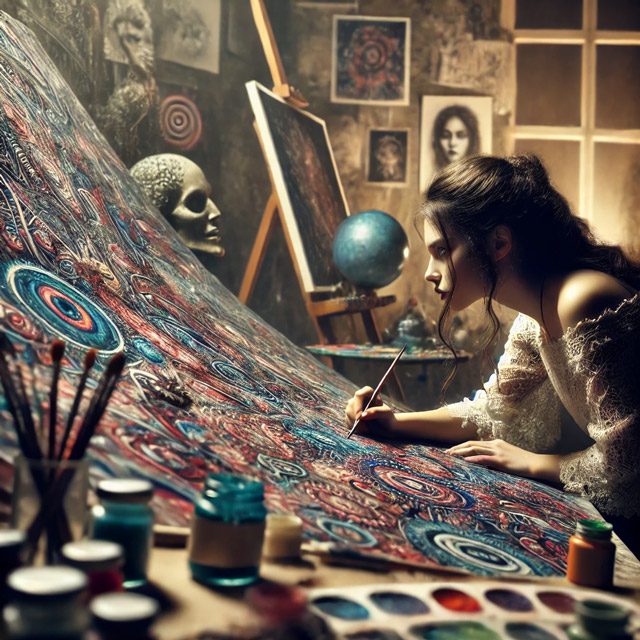
Ever walked into a room so cluttered you felt like the walls were closing in? The chaos, the overwhelming density of objects, the feeling that there’s no escape from the busyness—it’s more common than you think. This experience might just be horror vacui—the fear of empty space, an art principle that has captivated artists and audiences for centuries. From the intricate mosaics of the ancient Greeks to Gustav Klimt’s gold-filled canvases, horror vacui reflects a deep psychological need to fill every void, literal or metaphorical.
So, why are artists, across centuries, so compelled to cram every inch of their works with detail? Let’s explore how horror vacui has shaped artistic expression and why, despite the modern obsession with minimalism, the impulse to fill space with intricate patterns still thrives.
The Origins of Horror Vacui in Art History
Horror vacui isn’t some modern art trend born from a cluttered society. It’s been a core feature of human creativity for thousands of years. The term itself is Latin for “fear of empty space,” and throughout history, artists have taken this literally.
Ancient Civilizations and the Birth of Filled Spaces
Ancient Greeks, Mesopotamians, and Romans are among the earliest to use horror vacui in their art. Consider the ornate pottery of the Greeks, where no surface is left untouched by mythological scenes or decorative patterns. Similarly, Mesopotamian tomb carvings were filled with symbols, reflecting both a fear of emptiness and a desire to convey cultural meaning. Roman mosaics, which often adorned the walls and floors of villas, filled spaces with geometric designs and images from everyday life. For these civilizations, filling space wasn’t just aesthetic—it was symbolic of wealth, power, and divine order.
Medieval Manuscripts: Status Through Decoration
During the medieval period, horror vacui took on an even more devotional meaning. Illuminated manuscripts, painstakingly created by monks, are prime examples. Each page was crammed with intricate borders, elaborate illustrations, and embellished lettering, reflecting a sense of completeness and devotion. The absence of empty space in these religious texts symbolized the completeness of the divine word and the monk’s reverence.
In these works, horror vacui wasn’t simply decorative; it was a reflection of the belief that the divine must fill all spaces. Every detail served a purpose, leaving no room for ambiguity.
The Psychological Roots of Horror Vacui
Why do humans, and by extension artists, feel so compelled to fill every space? The answer lies deep in our psychology, blending cultural, aesthetic, and emotional motivations.
From Aristotle to Modern Anxiety
The roots of horror vacui in Western thought can be traced back to Aristotle, who suggested that “nature abhors a vacuum.” The idea was that empty spaces were unnatural, and the universe inherently sought to fill them. This principle carried over into art, where filling space became an artistic and even moral imperative.
In more modern terms, psychologists suggest that horror vacui in art might reflect human anxieties about the unknown. A blank space can represent uncertainty, while filling it can offer a sense of control. Artists may use horror vacui to ward off this anxiety, creating a sense of order in chaos by ensuring there’s always something to occupy the viewer’s gaze. It’s why some people prefer minimalist spaces, while others gravitate toward maximalism, constantly adding elements to their environment to create a sense of completeness.
Baroque and Rococo: Masters of Excess
Few periods in art history embraced horror vacui more fully than the Baroque and Rococo movements. These periods were all about filling space, whether on canvas or in architecture, with as much drama and detail as possible.
The Baroque: Grand, Bold, and Overflowing
Baroque artists, such as Peter Paul Rubens, embodied horror vacui in their massive, action-packed compositions. In Rubens’ works, no inch of the canvas is left to breathe; every corner is filled with movement, color, and emotion. His paintings, like The Garden of Love, draw the eye in every direction, leaving the viewer overwhelmed by the richness of the scene.
Architecturally, the Baroque style took this idea to new heights. Think of the elaborate interiors of churches or the palatial excess of places like the Palace of Versailles. Every surface, whether it be walls, ceilings, or even furniture, is covered in detailed patterns, frescoes, and gold embellishments.
Rococo: Elegance Through Overabundance
Rococo, which followed the Baroque, took horror vacui in a slightly different direction. It maintained the philosophy of filling space but added a more playful, elegant touch. Artists like Jean-Antoine Watteau crammed their compositions with cherubs, flowers, and pastel hues. In Rococo design, no chair or table leg was left unadorned. This wasn’t just art for the sake of excess—it was meant to evoke pleasure and luxury in a world where beauty was an end in itself.
Horror Vacui in Non-Western Art: A Global Phenomenon
Though horror vacui is often discussed in the context of Western art, it’s important to recognize that it is a global phenomenon, deeply embedded in non-Western cultures.
Islamic Art and the Geometry of Infinity
One of the most prominent examples of horror vacui outside Europe is Islamic art. Because Islamic tradition discourages the depiction of human figures, artists turned to intricate geometric patterns and calligraphy. Every surface—from mosque walls to manuscripts—was covered with repeating, interlocking designs. These patterns, symbolizing the infinite nature of God, filled every inch of space, leaving no room for emptiness.
African Textiles and Native American Pottery
African art, especially textiles, demonstrates another form of horror vacui. The densely packed patterns and symbols in textiles from cultures such as the Kuba people of Congo reflect social status, tribal history, and spiritual meaning. Similarly, Native American pottery, particularly from the Southwest, is often covered with symbolic designs that reference mythology and the natural world, filling every available space with intricate patterns.
Indian Miniatures: No Space Left Unfilled
In Indian miniature paintings, horror vacui is expressed through meticulous attention to detail. These paintings, which often depict court scenes or religious narratives, fill the canvas with layers of decoration, vibrant colors, and elaborate backgrounds. Every inch of space is dedicated to telling the story, and there’s always something new to discover upon closer inspection.
Modern Art’s Take on Horror Vacui
As we moved into modern art, horror vacui didn’t disappear. Instead, it evolved, finding new life in contemporary movements and artists.
Gustav Klimt: Filling the Void with Gold
Gustav Klimt, the Austrian symbolist painter, is one of the most notable modern artists to embrace horror vacui. In works like The Kiss, Klimt covered his figures with intricate patterns, swirling designs, and gold leaf. His paintings are packed with detail, creating an effect where every part of the canvas demands attention. Klimt’s horror vacui is not overwhelming but seductive, drawing the viewer into the luxurious fullness of his works.
Yayoi Kusama: Infinity Through Repetition
Japanese artist Yayoi Kusama takes horror vacui to the extreme with her obsession with polka dots. Her works—both paintings and large-scale installations—are filled with endless dots, creating the feeling that space is infinitely expanding. Kusama’s Infinity Mirror Rooms, where mirrors and dots seem to extend forever, embody the ultimate form of horror vacui. For Kusama, filling space is not just an aesthetic choice but a reflection of her inner world.
Street Art and Graffiti: Reclaiming Space
Street artists, particularly graffiti artists, are another modern example of horror vacui in action. These artists often aim to cover as much public space as possible, leaving no wall or surface untouched. The result is a kind of urban tapestry, where layers of paint, tags, and murals fill every inch, creating a vibrant yet chaotic display of artistic expression.
Horror Vacui in Interior Design and Pop Culture
In today’s world, horror vacui is no longer confined to fine art—it has made its way into interior design, fashion, and even film.
Maximalism in Interior Design
In recent years, maximalism has become a popular counter-movement to minimalism. Maximalist interiors are characterized by rooms overflowing with patterns, textures, and objects. Where minimalism strips spaces down to their bare essentials, maximalism embraces abundance, filling rooms with layers of detail that invite exploration. It’s horror vacui for the home, celebrating a space where there is always more to see.
Wes Anderson’s Cinematic Excess
Film director Wes Anderson is famous for his meticulously detailed sets, where every frame is packed with objects, textures, and symmetrical compositions. His films, such as The Grand Budapest Hotel, demonstrate a visual form of horror vacui, where the screen is filled with so much detail that the viewer can’t take it all in at once. Anderson’s style invites repeated viewings, as each time, there’s something new to notice.
Why Horror Vacui Still Fascinates Artists Today
Despite the popularity of minimalism in today’s design and art world, horror vacui continues to fascinate artists and viewers alike.
A Reaction to Minimalism
In many ways, horror vacui is a counterpoint to minimalism. Where minimalism values simplicity and emptiness, horror vacui celebrates excess and complexity. In a world that often prizes clean, empty spaces, horror vacui provides an antidote—a celebration of detail and abundance.
The Emotional and Psychological Appeal
For artists, horror vacui offers a way to express complexity, inner turmoil, or exuberance. By filling space with intricate details, they can create an emotional intensity that resonates with viewers. For those who experience this art, horror vacui can evoke both overwhelm and fascination, drawing the eye into the depths of the work.
The Void That Horror Vacui Fills
From the packed mosaics of ancient civilizations to Yayoi Kusama’s polka-dotted installations, horror vacui has always been a way to fill the void. It’s an artistic expression that speaks to our desire for fullness, complexity, and meaning in the spaces around us.
As Gustav Klimt once said, “Art is a line around your thoughts.” For artists who embrace horror vacui, that line never stops; it fills every corner of the canvas, turning space itself into a masterpiece.
FAQs
- What does horror vacui mean in art?
Horror vacui refers to the fear of empty space, often seen in art that fills every available surface with detail. - Which cultures are known for using horror vacui in their art?
Cultures like the Greeks, Islamic artists, and Native American tribes have all embraced horror vacui in various forms. - How does horror vacui differ from minimalism?
Horror vacui embraces fullness and detail, while minimalism seeks simplicity and empty space. - Is horror vacui only a historical art concept?
No, it remains popular today in movements like maximalist design and contemporary art by creators like Yayoi Kusama. - Can horror vacui be seen in architecture?
Yes, architectural spaces like the Palace of Versailles are prime examples of horror vacui, where no surface is left undecorated.
Key Takeaways
- Horror vacui is the artistic fear of empty space, where every inch is filled with detail.
- This concept can be traced back to ancient civilizations and remains influential today.
- Baroque and Rococo periods are iconic examples of horror vacui in European art.
- Non-Western cultures have also embraced horror vacui, particularly in textiles and pottery.
- Modern artists like Klimt and Kusama continue to explore horror vacui in their works.




